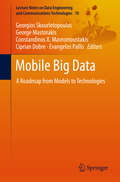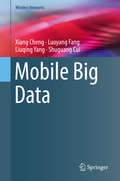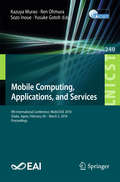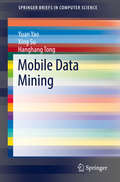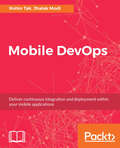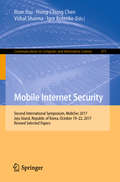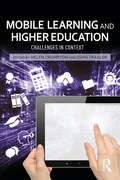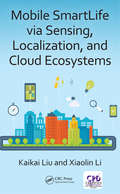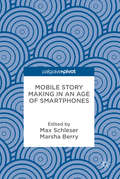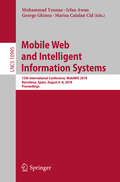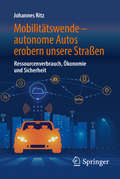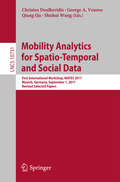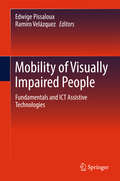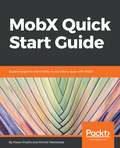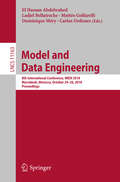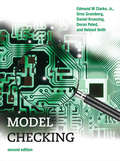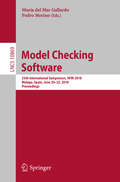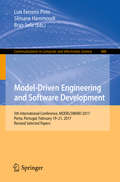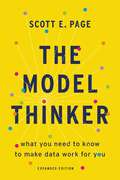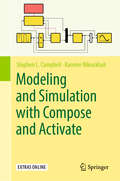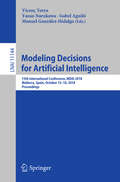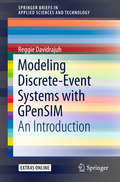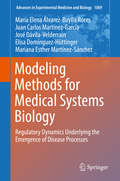- Table View
- List View
Mobile Big Data
by Georgios Skourletopoulos George Mastorakis Constandinos X. Mavromoustakis Ciprian Dobre Evangelos PallisThis book reports on the latest advances in mobile technologies for collecting, storing and processing mobile big data in connection with wireless communications. It presents novel approaches and applications in which mobile big data is being applied from an engineering standpoint and addresses future theoretical and practical challenges related to the big data field from a mobility perspective. Further, it provides an overview of new methodologies designed to take mobile big data to the Cloud, enable the processing of real-time streaming events on-the-move and enhance the integration of resource availability through the 'Anywhere, Anything, Anytime' paradigm. By providing both academia and industry researchers and professionals with a timely snapshot of emerging mobile big data-centric systems and highlighting related pitfalls, as well as potential solutions, the book fills an important gap in the literature and fosters the further development in the area of mobile technologies for exploiting mobile big data.
Mobile Big Data (Wireless Networks)
by Xiang Cheng Luoyang Fang Liuqing Yang Shuguang CuiThis book provides a comprehensive picture of mobile big data starting from data sources to mobile data driven applications. Mobile Big Data comprises two main components: an overview of mobile big data, and the case studies based on real-world data recently collected by one of the largest mobile network carriers in China. In the first component, four areas of mobile big data life cycle are surveyed: data source and collection, transmission, computing platform and applications. In the second component, two case studies are provided, based on the signaling data collected in the cellular core network in terms of subscriber privacy evaluation and demand forecasting for network management. These cases respectively give a vivid demonstration of what mobile big data looks like, and how it can be analyzed and mined to generate useful and meaningful information and knowledge. This book targets researchers, practitioners and professors relevant to this field. Advanced-level students studying computer science and electrical engineering will also be interested in this book as supplemental reading.
Mobile Computing, Applications, and Services: 9th International Conference, Mobicase 2018, Osaka, Japan, February 28 - March 2, 2018, Proceedings (Lecture Notes of the Institute for Computer Sciences, Social Informatics and Telecommunications Engineering #240)
by Yusuke Gotoh Sozo Inoue Ren Ohmura Kazuya MuraoThis book constitutes the thoroughly refereed post-conference proceedings of the 9th International Conference on Mobile Computing, Applications, and Services (MobiCASE 2015) held in Osaka, Japan, February 28 – March 2, 2018. The 10 full papers and 13 demo/ poster papers were carefully reviewed and selected from 35 submissions. The conference papers are covering intelligent caching; activity recognition and crowdsourcing; mobile frameworks; middleware; interactive applications; and mobility.
Mobile Data Mining (SpringerBriefs in Computer Science)
by Yuan Yao Xing Su Hanghang TongThis SpringerBrief presents a typical life-cycle of mobile data mining applications, including:data capturing and processing which determines what data to collect, how to collect these data, and how to reduce the noise in the data based on smartphone sensors feature engineering which extracts and selects features to serve as the input of algorithms based on the collected and processed data model and algorithm designIn particular, this brief concentrates on the model and algorithm design aspect, and explains three challenging requirements of mobile data mining applications: energy-saving, personalization, and real-time Energy saving is a fundamental requirement of mobile applications, due to the limited battery capacity of smartphones. The authors explore the existing practices in the methodology level (e.g. by designing hierarchical models) for saving energy. Another fundamental requirement of mobile applications is personalization. Most of the existing methods tend to train generic models for all users, but the authors provide existing personalized treatments for mobile applications, as the behaviors may differ greatly from one user to another in many mobile applications. The third requirement is real-time. That is, the mobile application should return responses in a real-time manner, meanwhile balancing effectiveness and efficiency. This SpringerBrief targets data mining and machine learning researchers and practitioners working in these related fields. Advanced level students studying computer science and electrical engineering will also find this brief useful as a study guide.
Mobile DevOps: Deliver continuous integration and deployment within your mobile applications
by Jhalak Modi Rohin TakThis step-by-step guide will teach you to continuously improve your mobile application development processKey Features●Efficiently deliver continuous integration and deployment within all the stages of your application's lifecycle●Learn to implement mobile DevOps with Xamarin and Visual Studio●Deliver high quality and performing mobile applicationsBook DescriptionToday's world is all about perfection, and there are hundreds of applications that are released each day out of which only a few succeed. Making sure that the app looks, performs, and behaves as expected is one of the biggest challenge developers face today.The main goal of this book is to teach developers to implement DevOps to build, test, and deliver. This book will teach you to implement Mobile DevOps at every stage of your application's lifecycle with Visual Studio and Xamarin Mobile Lifecycle solutions. Later, it will also show you how to leverage Mobile Center's continuous integration and automated testing to develop a high-quality applications. Next, you’ll see how to mobilize your on-premises data to the cloud and increase your productivity with code reuse. Finally, you’ll discover how to find and fix bugs beforehand, improving the efficiency of your application while it is being developed.By the end of this book, you will be well-versed with Mobile DevOps techniques, delivering high quality and high performance mobile apps.What you will learn●Become fluent with the basic components of Mobile Devops●Find out how to use code repositories and install Git on an EC2 server and manage users and groups●Set up an Android device for development and install Visual Studio and Xamarin on Windows●Create an Android project and UI for applications●Add permissions to Android Manifest●Write tests with Xamarin. UI and test using test cloud to check it on multiple devices●Monitor and optimize the application using the Android monitoring tool●Debug the mobile application and improve its efficiency Who this book is forIf you are a programmer and developer who wants to increase the efficiency and scalability of your mobile application with the implementation of DevOps, then this book is for you. You need basic experience of the application process development.
Mobile Internet Security: First International Symposium, Mobisec 2016, Taichung, Taiwan, July 14-15, 2016, Revised Selected Papers (Communications in Computer and Information Science #797)
by Ilsun You Hsing-Chung Chen Vishal Sharma Igor KotenkoThis book constitutes the refereed proceedings of the First International Symposium on Mobile Internet Security, MobiSec 2017, held in Jeju Island, Republic of Korea, in October 2017. <P><P>The 13 revised full papers along with a short paper presented were carefully reviewed and selected from 44 submissions. They are closely related to various theories and practical applications in mobility management to highlight the state-of-the-art research.
Mobile Learning and Higher Education: Challenges in Context
by Helen Crompton John TraxlerMobile Learning and Higher Education provides case studies of mobile learning in higher education settings to showcase how devices can transform learning at the undergraduate and graduate levels. With the rapid diffusion of networked technologies among the adult populations of many countries and the supersession of the once-ubiquitous lecture approach with active learner-centered teaching for deep understanding, mobile devices are increasingly used in higher education classrooms to offer unique and effective new approaches to teaching and learning. A cutting-edge research volume, this collection also provides a springboard for building better practices in higher education institutions.
Mobile SmartLife via Sensing, Localization, and Cloud Ecosystems
by Kaikai Liu Xiaolin LiIndoor location is one of the two most important contexts (time and location), becoming a key entry for mobile Internet. This book envisions potential indoor location applications, overviews the related state of the art technologies, and presents original patented techniques and open source prototype systems. The tutorial and sample code are provided as a good reference and starting point for readers who are interested in the technique detail.
Mobile Story Making in an Age of Smartphones
by Marsha Berry Max SchleserThe participatory turn in media, arts and design along with interrelated developments in the proliferation of social and network media have changed our understanding of the contemporary mediascape. Mobile Story Making in an Age of Smartphones reveals how smartphones and storytelling are forming a symbiosis that empowers twenty-first century citizens and creatives around the world. The edited collection further develops definitions and debate around creative mobile media and its impact on media, art and design. It brings together mobile artists, digital ethnographers, filmmakers working with smartphones, illustrators, screenwriters as well as musicians utilizing apps and mobile devices, who explore new directions in the creative arts with a focus on screen production. Lastly, it demonstrates how mobile devices and smartphones can make a difference in peoples’ lives and catalyses creativity in order to tackle current socio-cultural issues.
Mobile Web and Intelligent Information Systems: 15th International Conference, MobiWIS 2018, Barcelona, Spain, August 6-8, 2018, Proceedings (Lecture Notes in Computer Science #10995)
by Muhammad Younas Irfan Awan George Ghinea Marisa Catalan CidThis book constitutes the refereed proceedings of the 15th International Conference on Mobile Web and Intelligent Information Systems, MobiWIS 2018, held in Barcelona, Spain, in August 2018. The 15 full papers together with 2 short papers presented in this volume were carefully reviewed and selected from 50 submissions. The papers of the MobiWIS 2018 deal with areas such as: mobile web and apps, wireless sensor networks, web services, cloud services, web applications, and various web technologies.
Mobilitätswende – autonome Autos erobern unsere Straßen
by Johannes RitzDieses Buch beleuchtet die unterschiedlichen Facetten einer Mobilität mit selbstfahrenden (autonomen) Fahrzeugen. Angefangen bei der Elektromobilität, werden die Parkplatzproblematik, Carsharing und Haftungsfragen unter dem Aspekt einer zunehmenden Verbreitung autonomer Fahrzeuge betrachtet. Auch ökonomische und umweltpolitische Fragen sind aufgeworfen (Ressourcenknappheit, Klimawandel, automatisierte Logistik) und versucht zu beantworten. Können Maschinen moralisch handeln, wie steht es um die Cybersicherheit und den Technikmissbrauch, sind weitere Fragen, die in diesem Buch thematisiert werden.
Mobility Analytics for Spatio-Temporal and Social Data: First International Workshop, MATES 2017, Munich, Germany, September 1, 2017, Revised Selected Papers (Lecture Notes in Computer Science #10731)
by Christos Doulkeridis George A. Vouros Qiang Qu Shuhui WangThis book constitutes the refereed post-conference proceedings of the First International Workshop on Mobility Analytics for Spatio-Temporal and Social Data, MATES 2017, held in Munich, Germany, in September 2017. The 6 revised full papers and 2 short papers included in this volume were carefully reviewed and selected from 13 submissions. Also included are two keynote speeches. The papers intend to raise awareness of real-world problems in critical domains which require novel data management solutions. They are organized in two thematic sections: social network analytics and applications, and spatio-temporal mobility analytics.
Mobility of Visually Impaired People
by Edwige Pissaloux Ramiro VelazquezThis book discusses the design of the new mobility assistive information and communication technologies (ICT) devices for the visually impaired. The book begins with a definition of the space concept, followed by the concept of interaction with a space during mobility and this interaction characteristics. The contributors will then examine the neuro-cognitive basis of space perception for mobility and different theories of space perception. The text presents the existing technologies for space perception (sense recovery with stem and iPS cells, implants, brain plasticity, sensory substitution devices, multi modal technologies, etc.), the newest technologies for mobility assistance design, the way the feedback on environment is conveyed to the end-user. Methods for formative and summative evaluations of the mobility devices will also be discussed. The book concludes with a look to the future trends in research and technology development for mobility assistive information and communication technologies. <P><P><i>Advisory: Bookshare has learned that this book offers only partial accessibility. We have kept it in the collection because it is useful for some of our members. Benetech is actively working on projects to improve accessibility issues such as these.</i>
MobX Quick Start Guide: Supercharge the client state in your React apps with MobX
by Pavan Podila Michel WeststrateApply functional Reactive programming for simple and scalable state management with MobXKey FeaturesThe easiest way to learn MobX to enhance your client-side state-managementUnderstand how the concepts and components fit togetherWork through different state management scenarios with MobXBook DescriptionMobX is a simple and highly scalable state management library in JavaScript. Its abstractions can help you manage state in small to extremely large applications. However, if you are just starting out, it is essential to have a guide that can help you take the first steps. This book aims to be that guide that will equip you with the skills needed to use MobX and effectively handle the state management aspects of your application.You will first learn about observables, actions, and reactions: the core concepts of MobX. To see how MobX really shines and simplifies state management, you'll work through some real-world use cases. Building on these core concepts and use cases, you will learn about advanced MobX, its APIs, and libraries that extend MobX.By the end of this book, you will not only have a solid conceptual understanding of MobX, but also practical experience. You will gain the confidence to tackle many of the common state management problems in your own projects.What you will learnExplore the fundamental concepts of MobX, such as observables, actions, and reactionsUse observables to track state and react to its changes with validations and visual feedback (via React Components)Create a MobX observable from different data typesDefine form data as an observable state and tackle sync and async form validationsUse the special APIs to directly manipulate observables, tracking its changes, and discovering the reasons behind a changeTackle any state management issue you may have in your app by combining mobx-utils and mobx-state-treeExplore the internals of the MobX reactive system by diving into its inner workingsWho this book is forThis book is for web developers who want to implement easy and scalable state management for their apps. Knowledge of HTML, CSS, and JavaScript is assumed
#Moby-Dick; Or, The Whale: A Literary Classic Told in Tweets for the 21st Century Audience (Twit Lit Classics)
by Mike BezemekMoby Dick is regularly hailed as one of the greatest works of American literature. But suppose Ishmael had instead shared his tale in tweets? #Moby-Dick or The Whale in Tweets hilariously reimagines Herman Melville's classic whaling novel in just 200 tweets, each 140 characters or less. Ishmael here! Went broke in NYC, Super bored with land (damp drizzly soul,) I'm going to sea! #callme #whalingvoyage In this witty abridgment, mad captain Ahab's quest for vengeance upon a white whale is retold with Internet acronyms. The plight of the Pequod and its motley crew is punctuated by the occasional emoji. And Ishmael ponders whaling and humanity with hashtags. Including an appendix that presents the original passages upon which each tweet is derived, #Moby Dick offers modern readers an entertaining and accessible companion to a great American classic.
Model and Data Engineering: 8th International Conference, MEDI 2018, Marrakesh, Morocco, October 24–26, 2018, Proceedings (Lecture Notes in Computer Science #11163)
by El Hassan Abdelwahed Ladjel Bellatreche Mattéo Golfarelli Dominique Méry Carlos OrdonezThis book constitutes the refereed proceedings of the 8h International Conference on Model and Data Engineering, MEDI 2018, held in Marrakesh, Morocco, in October 2018.The 23 full papers and 4 short papers presented together with 2 invited talks were carefully reviewed and selected from 86 submissions. The papers covered the recent and relevant topics in the areas of databases; ontology and model-driven engineering; data fusion, classsification and learning; communication and information technologies; safety and security; algorithms and text processing; and specification, verification and validation.
Model Checking, second edition (Cyber Physical Systems Series)
by Edmund M. Clarke Orna Grumberg Daniel Kroening Doron Peled Helmut VeithAn expanded and updated edition of a comprehensive presentation of the theory and practice of model checking, a technology that automates the analysis of complex systems.Model checking is a verification technology that provides an algorithmic means of determining whether an abstract model—representing, for example, a hardware or software design—satisfies a formal specification expressed as a temporal logic formula. If the specification is not satisfied, the method identifies a counterexample execution that shows the source of the problem. Today, many major hardware and software companies use model checking in practice, for verification of VLSI circuits, communication protocols, software device drivers, real-time embedded systems, and security algorithms. This book offers a comprehensive presentation of the theory and practice of model checking, covering the foundations of the key algorithms in depth. The field of model checking has grown dramatically since the publication of the first edition in 1999, and this second edition reflects the advances in the field. Reorganized, expanded, and updated, the new edition retains the focus on the foundations of temporal logic model while offering new chapters that cover topics that did not exist in 1999: propositional satisfiability, SAT-based model checking, counterexample-guided abstraction refinement, and software model checking. The book serves as an introduction to the field suitable for classroom use and as an essential guide for researchers.
Model Checking Software: 25th International Symposium, SPIN 2018, Malaga, Spain, June 20-22, 2018, Proceedings (Lecture Notes in Computer Science #10869)
by María Del Gallardo Pedro MerinoThis book constitutes the refereed proceedings of the 25th International Symposium on Model Checking Software, SPIN 2018, held in Malaga, Spain, in June 2018.The 14 papers presented, 1 short paper, and 1 demo-tool paper, were carefully reviewed and selected from 28 submissions. Topics covered include formal verification techniques for automated analysis of software; formal analysis for modeling languages, such as UML/state charts; formal specification languages, temporal logic, design-by-contract; model checking, automated theorem proving, including SAT and SMT; verifying compilers; abstraction and symbolic execution techniques; and much more.
Model-Driven Engineering and Software Development: 5th International Conference, MODELSWARD 2017, Porto, Portugal, February 19-21, 2017, Revised Selected Papers (Communications in Computer and Information Science #880)
by Luís Ferreira Pires Slimane Hammoudi Bran SelicThis book constitutes thoroughly revised and selected papers from the 5th International Conference on Model-Driven Engineering and Software Development, MODELSWARD 2017, held in Porto, Portugal, in February 2017. The 20 thoroughly revised and extended papers presented in this volume were carefully reviewed and selected from 91 submissions. They contribute to the development of highly relevant research trends in model-driven engineering and software development such as methodologies for MDD development and exploitation, model-based testing, model simulation, domain-specific modeling, code generation from models, new MDD tools, multi-model management, model evolution, and industrial applications of model-based methods and technologies.
The Model Thinker: What You Need to Know to Make Data Work for You
by Scott E. PageHow anyone can become a data ninja From the stock market to genomics laboratories, census figures to marketing email blasts, we are awash with data. But as anyone who has ever opened up a spreadsheet packed with seemingly infinite lines of data knows, numbers aren't enough: we need to know how to make those numbers talk. In The Model Thinker, social scientist Scott E. Page shows us the mathematical, statistical, and computational models--from linear regression to random walks and far beyond--that can turn anyone into a genius. At the core of the book is Page's "many-model paradigm," which shows the reader how to apply multiple models to organize the data, leading to wiser choices, more accurate predictions, and more robust designs. The Model Thinker provides a toolkit for business people, students, scientists, pollsters, and bloggers to make them better, clearer thinkers, able to leverage data and information to their advantage.
Modeling and Simulation with Compose and Activate
by Ramine Nikoukhah Stephen L. CampbellThis book provides a tutorial in the use of Compose and Activate, software packages that provide system modeling and simulation facilities. Advanced system modeling software provide multiple ways of creating models: models can be programmed in specialized languages, graphically constructed as block-diagrams and state machines, or expressed mathematically in equation-based languages. Compose and Activate are introduced in this text in two parts. The first part introduces the multi-language environment of Compose and its use for modeling, simulation and optimization. The second describes the graphical system modeling and optimization with Activate, an open-system environment providing signal-based modeling as well as physical system component-based modeling. Throughout both parts are applied examples from mechanical, biological, and electrical systems, as well as control and signal processing systems. This book will be an invaluable addition with many examples both for those just interested in OML and those doing industrial scale modeling, simulation, and design. All examples are worked using the free basic editions of Activate and Compose that are available.
Modeling Decisions for Artificial Intelligence: 15th International Conference, MDAI 2018, Mallorca, Spain, October 15–18, 2018, Proceedings (Lecture Notes in Computer Science #11144)
by Vicenç Torra Yasuo Narukawa Isabel Aguiló Manuel González-HidalgoThis book constitutes the proceedings of the 15th International Conference on Modeling Decisions for Artificial Intelligence, MDAI 2018, held in Mallorca, Spain, in October 2018.The 24 papers presented in this volume were carefully reviewed and selected from 43 submissions. The book also contains one invited talk in full paper length. The papers were organized in topical sections named: aggregation operators, fuzzy measures and integrals; decision making; clustering and classification; and data privacy and security.
Modeling, Design, Construction, and Operation of Power Generators with Solid Oxide Fuel Cells: From Single Cell To Complete Power System (Green Energy And Technology)
by Jakub KupeckiThe book summarizes the current state of the solid oxide fuel cell (SOFC) technology in power generation applications. It describes the single cells, SOFC stacks, micro-combined heat and power systems, large-scale stationary power generators and polygeneration units. The principles of modeling, simulation and controls of power systems with solid oxide fuel cells are presented and discussed. Authors provide theoretical background of the technology followed by the essential insights into the integrated power systems. Selected aspects of the design, construction and operation of power units in range from single kilowatts to hundreds of kilowatts are presented. Finally, the book reports the selected studies on prototype systems which have been constructed in Europe.The book discusses the theoretical and practical aspects of operation of power generators with solid oxide fuel cells including fabrication of cells, design of stacks, system modeling, simulation of stationary and non-stationary operation of systems, fuel preparation and controls.
Modeling Discrete-Event Systems with GPenSIM: An Introduction (SpringerBriefs in Applied Sciences and Technology)
by Reggie DavidrajuhModeling Discrete-Event Systems with GPenSIM describes the design and applications of General Purpose Petri Net Simulator (GPenSIM), which is a software tool for modeling, simulation, and performance analysis of discrete-event systems. The brief explains the principles of modelling discrete-event systems, as well as the design and applications of GPenSIM. It is based on the author’s lectures that were given on “modeling, simulation, and performance analysis of discrete event systems”. The brief uses GPenSIM to enable the efficient modeling of complex and large-scale discrete-event systems. GPenSIM, which is based on MATLAB®, is designed to allow easy integration of Petri net models with a vast number of toolboxes that are available on the MATLAB®. The book offers an approach for developing models that can interact with the external environment; this will help readers to solve problems in industrial diverse fields. These problems include:airport capacity evaluation for aviation authorities;finding bottlenecks in supply chains;scheduling drilling operations in the oil and gas industry; andoptimal scheduling of jobs in grid computing. This brief is of interest to researchers working on the modeling, simulation and performance evaluation of discrete-event systems, as it shows them the design and applications of an efficient modeling package. Since the book also explains the basic principles of modeling discrete-event systems in a step-by-step manner, it is also of interest to final-year undergraduate and postgraduate students.
Modeling Methods for Medical Systems Biology: Regulatory Dynamics Underlying the Emergence of Disease Processes (Advances in Experimental Medicine and Biology #1069)
by María Elena Álvarez-Buylla Roces Juan Carlos Martínez-García José Dávila-Velderrain Elisa Domínguez-Hüttinger Mariana Esther Martínez-SánchezThis book contributes to better understand how lifestyle modulations can effectively halt the emergence and progression of human diseases. The book will allow the reader to gain a better understanding of the mechanisms by which the environment interferes with the bio-molecular regulatory processes underlying the emergence and progression of complex diseases, such as cancer. Focusing on key and early cellular bio-molecular events giving rise to the emergence of degenerative chronic disease, it builds on previous experience on the development of multi-cellular organisms, to propose a mathematical and computer based framework that allows the reader to analyze the complex interplay between bio-molecular processes and the (micro)-environment from an integrative, mechanistic, quantitative and dynamical perspective. Taking the wealth of empirical evidence that exists it will show how to build and analyze models of core regulatory networks involved in the emergence and progression of chronic degenerative diseases, using a bottom-up approach.
